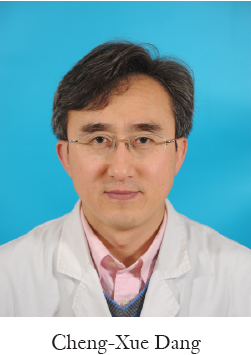Laparoscopy-assisted D2 radical distal gastrectomy
Video description

General data
A 36-year-old male patient was admitted due to “dull pain and discomfort in the upper abdomen”. Gastroscopy indicated a poorly differentiated adenocarcinoma (1 cm × 1 cm in size) near gastric antrum. A diagnosis of “early gastric cancer” was made. Preoperative examinations showed that there were no definite contraindications for surgery. Laparoscopy-assisted radical distal gastrectomy was then scheduled.
Surgical procedures
Routine preparation for laparoscopy was made after the patient was satisfactorily anesthetized. Abdominal exploration showed that the abdominal parietal and visceral layers were not obviously adhered, no metastasis was found in pelvic/abdominal aortic lymph nodes or mesenteric lymph nodes, and the liver surface was smooth. Since the findings were consistent with the pre-operative diagnosis, laparoscopy-assisted D2 radical distal gastrectomy was performed (Video 1): the gastrocolic ligament was divided along the left border of the transverse colon to expose the transverse mesocolon. After the anterior lobe of the transverse mesocolon was resected from left to right, dissect the anterior lobe of pancreas envelope, during which the middle colic artery must be carefully protected. Superior mesenteric artery and vein was found through the middle colic artery, and the gastrocolic trunk of Henle was exposed. After the right gastroepiploic vein and artery were exposed and divided, the Group 6 lymph nodes were dissected. After the gastroduodenal artery was dissociated, the gastroduodenal artery, right gastric artery, and common hepatic artery and its branches were further dissected. The right gastric artery and vein were then exposed and divided. The portal vein was dissociated inside the hepatoduodenal ligament, and the groups 5 and 12a lymph nodes were dissected. The gastric antrum and the inferior-posterior wall of duodenal posterior wall were dissected, during which damage to structures within the hepatoduodenal ligament due to surgical instrument should be avoided. Celiac trunk can be found along the common hepatic artery. After the transection of left gastric artery and vein, the groups 7, 8, and 9 lymph nodes were dissected, followed by the dissection of group 11p after the dissociation of splenic artery and vein, during which any variation of celiac artery and splenic artery should be considered. Beginning from the lower pole of the spleen, divide the greater curvature of stomach to the right upper side. After the left gastroepiploic vein was divided and ligated, open the gastrosplenic ligament, transect one or two short gastric arteries inside the ligament with HIFU and then dissect group 4sb lymph node. Divide the hepatogastric ligament and the anterior lobe of hepatoduodenal ligament, dissect the groups 1 and 3 lymph nodes, and then thoroughly dissociate the upper wall of duodenum and gastric antrum. A 4-6-cm upper abdominal median incision was made at the beginning of the operation. A specimen retrieval bag was used to protect the incision. Transect the duodenum under the pylorus. Radical distal gastrectomy was performed after the distal stomach was pulled out of the peritoneal cavity. Billroth-I anastomosis was performed for the residual stomach and the duodenal stump. Stop the bleeding, indwel the drainage tube, and then suture the incision.
Post-operative pathology and staging
The dissected lymph nodes included: lymph nodes at lesser curvature of the stomach, 14; lymph nodes at greater curvature of stomach, 4; supra-pyloric lymph nodes, 2; and sub-pyloric lymph nodes, 6. The TNM stage was T1N0M0.
Acknowledgements
Disclosure: The authors declare no conflict of interest.


